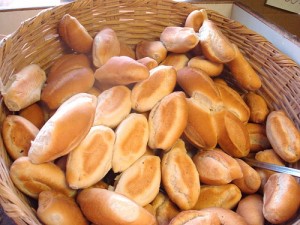 The price of Mexican bolillos (hard buns) will rise. So will the price of pastries, pastas, crackers, flour tortillas and loaf breads. This was the announcement of Leopoldo Gonzalez, president of the National Chamber of the Bread Industry (Canainpa). In fact, the price of flour to make these products has already has gone up 20%. By mid-August the price of the grain had risen on the international market around 50% compared to June.
The price of Mexican bolillos (hard buns) will rise. So will the price of pastries, pastas, crackers, flour tortillas and loaf breads. This was the announcement of Leopoldo Gonzalez, president of the National Chamber of the Bread Industry (Canainpa). In fact, the price of flour to make these products has already has gone up 20%. By mid-August the price of the grain had risen on the international market around 50% compared to June.
Behind the increase in prices and the volatility that proceeded it lays an alarming situation. But, true to style, the federal government has minimized the seriousness of it. For them, its just a “slight cold” without major consequences. In an official communiqué, the authorities in charge assured the public that there are wheat supplies in the world. They forget that in 2008, when the price crisis exploded, there was a record harvest of the grain on the international level.
The multilateral organizations think otherwise. The high volatility of wheat pries, but also of corn and rice, constitute, according to the World Bank, “an additional risk” to the prevailing crisis. The poorest now pay more for food. For small producers it is an additional burden, sine they have fewer mechanisms to confront the fluctuations. According to the Bank, the average variation of prices for a group of 26 low-income countries has been greater that that observed in years prior to the food crisis.
Wheat is the second most important grain in the Mexican diet, after corn. It is basically a commercial product. Cultivation for self-consumption is very limited. It is grown in 24 states, the main ones being Sonora, Baja California and Guanajuato.
As in other agricultural sectors, the farmers who grow it see very little of the benefits compared to the processors. Although prices vary, a bolillo costs that weighs between 60 and 65 grams costs about 1.80 pesos. A wheat producer in Mexico received 2.70 pesos for every kilo of grain. This means that he or she obtained nearly 17 times less than what the consumer pays for the piece of bread. In the case of pasta, crackers and cookies, and pastries the difference between the price of the raw material and the final product tends to be even greater.
According to the information service of the Secretary of Agriculture, Livestock, Rural Development, Food and Fisheries (SAGARPA), Mexico produces 4.2 million tons of wheat a year but imports 3.5 million tons. Ironic tragedy for a country that in 1951 was self-sufficient in the grain and throughout the years exported part of its surplus. Trade and investment liberalization that stimulated the entry of foreign food supplies, and the government’s decision to stop protecting national crops and withdraw programs to stimulate national production provoked an enormous dependency on other countries for basic foods.
For humans to consume wheat requires a process that usually begins at the mill. The first product is flour. This is why the flour industry is the central link between farmers and consumers. The Mexican flour industry has nearly 95 mills operating. Four companies concentrate 53.6% of the market, according to food researcher Ana de Ita at the Center for studies of rural change in the Mexican countryside. The makes it easy for these companies to influence consumer prices in the case of international drop in supply.
The increase in the international price of wheat was caused by speculators, along with the decision of the Russian government to close its borders to exportation of the grain from August 15 to December 31 2010. Russia made the decision to guarantee internal supplies, worried about the loss in harvests as a result of the drought and fires. Climate change has also affected crops in the Ukraine, Canada and Pakistan.
The rise in prices comes in the context of expectations for world production and inventories well over those registered in 2008. The harvests in the past two years were excellent. The global ratio of reserves is equivalent, according to the FAO, to 28% of world consumption. This season will generate 644 million tons of the grain, the third largest harvest registered in history. This means that the price increase responds to speculative actions in investment funds in the wheat futures market.
Non-commercial investment, which includes the operation of investment funds and hedge funds, on the futures market in Chicago is equivalent to 31% of negotiated contracts. In early August, the technical indicators futures on wheat were close to levels of over-buying. The announcement of difficulties economic in the United States will drive speculative money to return to flow copiously to futures markets of raw materials, including food.
This speculation with agricultural products is nothing new. Frederick Kaufman published an excellent article in Harper’s magazine entitled “How Wall Street Starved millions and Got Away With It” that details the role that was played by Goldman Sachs and other financial institutions in the hunger crisis of 2008.
The current increase in wheat prices reminds us of the irrationality of having food prices set by the commodities markets. Food should be outside of market instruments that serve to speculate and should be considered a public good. Nations should have the right to produce what their populations need to feed themselves. Agriculture should be outside the World Trade Organization. If this does not happen, the number of hungry people in the world will increase as well.
Luis Hernandez Navarro is the Opinions Editor of the Mexican daily newspaper La Jornada.
Translated by: Laura Carlsen



